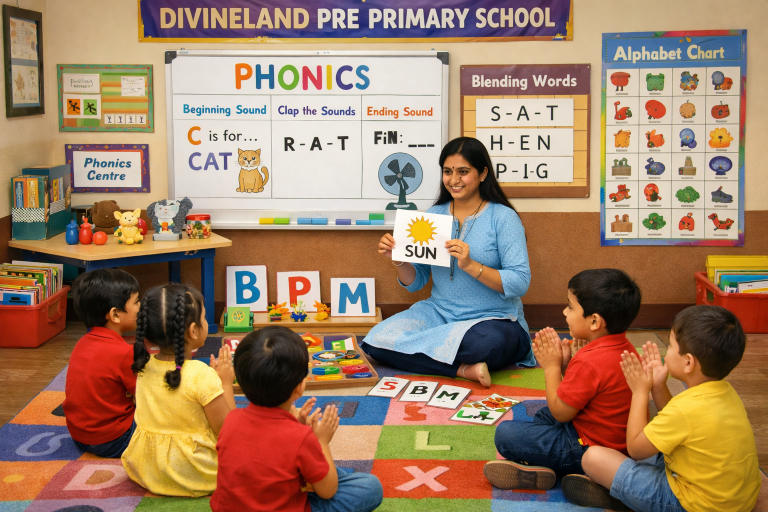
Learning to read by your child begins with learning sounds, and that is where phonics comes in. When you teach phonics to your child, you enable them to associate letters with sounds, setting the stage for reading and spelling achievement.
Parents always wonder, “How do I Teach Phonics to My Child?” With a little creativity and the proper methodology, you can easily instruct phonics in your child at home and see their confidence increase with each new word they read.
Begin with Letter Sounds
The initial action in teaching phonics to your child is to teach letter sounds, not letter names. For instance, rather than using the “bee” pronunciation for the letter B, use the /b/ sound. This allows your child to understand that sounds construct words.
- Use basic consonant sounds such as s, m, t, p, and a.
- Speak the sound slowly and clearly.
- Let your child echo and look around for items that begin with the same sound.
The more your child is exposed to and practices, the simpler it is to teach phonics to your child in meaningful ways.
Call or Whatsapp on +918591021373 / +919082778593, for Admission Details!
For downloading the brochure, Click Here!
Make Use of Visual Aids and Flashcards
Kids are visual, so using pictorial flashcards can help with teaching phonics to your child. Associating an image with a letter helps connections get made. For instance, a card with “A for Apple” enables your child to view the letter, listen to the sound, and identify the object.
You can also:
- Show alphabet charts on walls.
- Utilize colourful letters or magnets for playtime.
- Encourage your child to practice tracing letters with his or her fingers.
These exercises practice recognition and sound association — valuable steps when you’re teaching phonics to your child.
Teach Blending Sounds
After your child is comfortable with single sounds, it’s time to teach your child phonics using blending. Blending is putting single sounds together to make words. For instance, /c/ + /a/ + /t/ is “cat.”
This is how you can do it:
- Say the individual sound slowly, then start blending them.
- Ask your child to repeat and utter the whole word.
- Take short words that are easy to say such as “dog,” “sun,” or “man.”
By constantly Teaching Phonics to your child using blending, it will improve his decoding skill so that he can easily read unfamiliar words.
Make Learning Fun through Games
Phonics should be enjoyable! Add fun games and activities to keep them engaged while you teach your child phonics. You can attempt:
- Sound hunts: Find the items in the room that make a specific sound.
- Phonics bingo: Identify sounds with pictures or letters.
- Jump and say: Place letters on the floor and have your child jump on the corresponding sound when you utter it.
Interactive play keeps your child engaged and enables you to teach phonics to your child in a fun manner.

Read Aloud Daily
Reading out loud is one of the most effective methods of teaching phonics to your child. Select picture books containing repetitive sounds and rhyming words. When reading:
- Highlight the sounds within words.
- Have your child point out known letters.
- Get them to repeat basic words or predict what is coming next.
Reading as a family daily reinforces sound identification and enhances vocabulary — one of your objectives when you regularly teach phonics to your child.
Introduce Word Families
When teaching phonics to your child, work on word families such as -at, -an, -it, -ot, and -ug. These sets of words have common patterns and thus are simpler to master.
For instance:
- Cat, hat, bat (the “-at” family)
- Pan, fan, man (the “-an” family)
Have your child read or write rhyming words from each family. It is one way to teach phonics to your child in patterns they will easily remember and use.
Utilize Songs and Rhymes
Songs and rhymes are great aids when teaching phonics to your child. Nursery rhymes have repetitive sounds that are easy to hear and recognize by children.
Try:
- Singing alphabet songs.
- Chanting rhymes that emphasize letter sounds.
- Developing your own sound-tunes.
Music will naturally catch children’s attention, and you can use music to teach phonics to your child in terms of rhythm and melody.
Call or Whatsapp on +918591021373 / +919082778593, for Admission Details!
For downloading the brochure, Click Here!
Be Consistent and Patient
Consistency is greater than speed when teaching phonics to your child. Keep each session brief, about 10–15 minutes a day. Praise little successes, and repeat exercises for reinforcement. Just like every kid is different, so too are they different learners — encouragement and patience are well worth it.
- Establish a regular phonics time each day.
- Present sounds learned earlier are regularly.
- Encourage your child with praise for effort, not precision.
With regular practice, your efforts to impart phonics to your child will begin to yield results soon.
Make Phonics a Part of Daily Life
Phonics study need not be limited to the study table. You can impart phonics to your child anywhere — shopping, cooking, or strolling outdoors.
- Identify letters on signboards or packets of food.
- Get your child to take an educated guess at the beginning sound of words they hear.
- Seize everyday moments to reinforce sounds.
Daily learning helps make it simple to organically teach phonics to your child while developing their listening and observing skills.
As you begin to teach your child phonics, never forget that patience, play, and consistency are the most important. To start with, sounds, add pictures, blend words, read alongside your child, and practice in daily moments, is to make phonics learning fun and enduring. Each little step you take in teaching phonics to your child leads them closer to reading confidence and an affection for words that they will keep for life.
Helping your child build a strong reading foundation starts with the right phonics approach. With expert guidance and engaging learning methods, your little one can master sounds and words confidently. If you’re ready to make reading fun and effective, enroll your child in Divineland’s Phonics Classes, where learning phonics becomes an exciting journey toward early literacy success.
Begin Your Child’s Phonics Adventure at Divineland’s Phonics Classes today!
Call or Whatsapp on +918591021373 / +919082778593, for Admission Details!
For downloading the brochure, Click Here!
How do I Teach Phonics to My Child?
FAQs
What is the Best Age to Begin Teaching Phonics to My Child?
You can begin phonics at the age of 3–4 when your child starts identifying letters and has an interest in sounds and words.
How Can I Make Phonics Learning Fun at Home?
Utilize songs, rhymes, and letter sound games. Keep it short and fun to make learning phonics a daily enjoyment for your child.
Where Can My Child Learn Phonics Properly?
Join Divineland's Phonics Classes where kids learn in fun, engaging, and interactive ways to develop solid reading ability.


